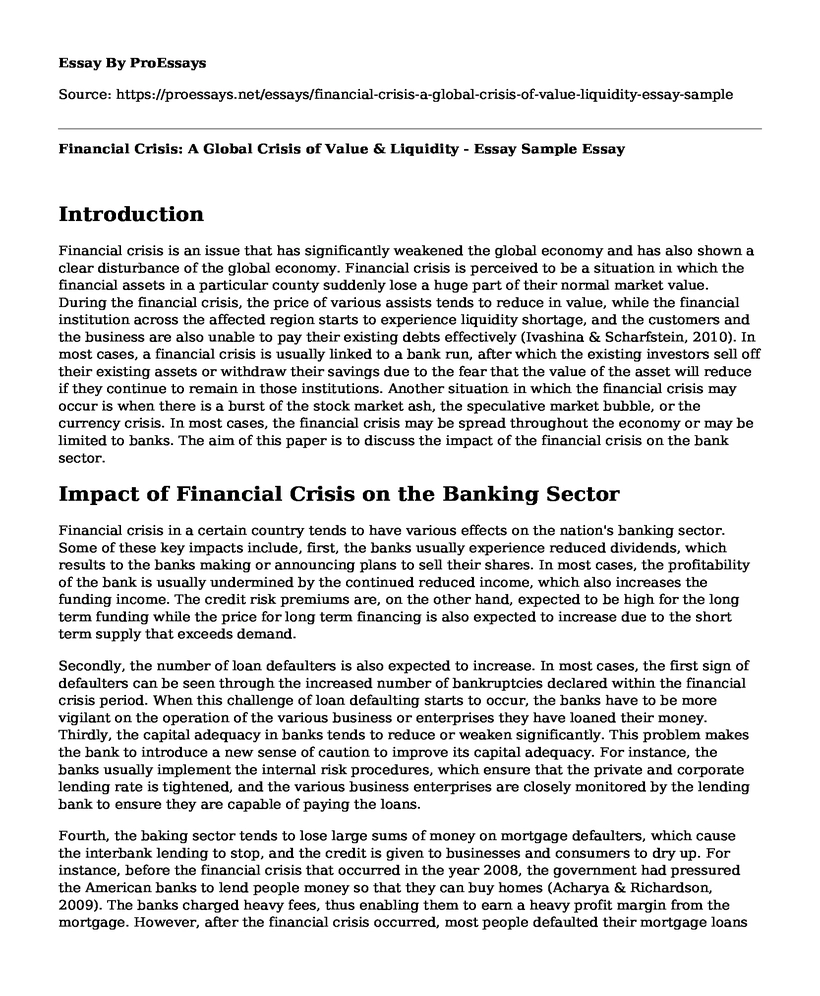Introduction
Financial crisis is an issue that has significantly weakened the global economy and has also shown a clear disturbance of the global economy. Financial crisis is perceived to be a situation in which the financial assets in a particular county suddenly lose a huge part of their normal market value. During the financial crisis, the price of various assists tends to reduce in value, while the financial institution across the affected region starts to experience liquidity shortage, and the customers and the business are also unable to pay their existing debts effectively (Ivashina & Scharfstein, 2010). In most cases, a financial crisis is usually linked to a bank run, after which the existing investors sell off their existing assets or withdraw their savings due to the fear that the value of the asset will reduce if they continue to remain in those institutions. Another situation in which the financial crisis may occur is when there is a burst of the stock market ash, the speculative market bubble, or the currency crisis. In most cases, the financial crisis may be spread throughout the economy or may be limited to banks. The aim of this paper is to discuss the impact of the financial crisis on the bank sector.
Impact of Financial Crisis on the Banking Sector
Financial crisis in a certain country tends to have various effects on the nation's banking sector. Some of these key impacts include, first, the banks usually experience reduced dividends, which results to the banks making or announcing plans to sell their shares. In most cases, the profitability of the bank is usually undermined by the continued reduced income, which also increases the funding income. The credit risk premiums are, on the other hand, expected to be high for the long term funding while the price for long term financing is also expected to increase due to the short term supply that exceeds demand.
Secondly, the number of loan defaulters is also expected to increase. In most cases, the first sign of defaulters can be seen through the increased number of bankruptcies declared within the financial crisis period. When this challenge of loan defaulting starts to occur, the banks have to be more vigilant on the operation of the various business or enterprises they have loaned their money. Thirdly, the capital adequacy in banks tends to reduce or weaken significantly. This problem makes the bank to introduce a new sense of caution to improve its capital adequacy. For instance, the banks usually implement the internal risk procedures, which ensure that the private and corporate lending rate is tightened, and the various business enterprises are closely monitored by the lending bank to ensure they are capable of paying the loans.
Fourth, the baking sector tends to lose large sums of money on mortgage defaulters, which cause the interbank lending to stop, and the credit is given to businesses and consumers to dry up. For instance, before the financial crisis that occurred in the year 2008, the government had pressured the American banks to lend people money so that they can buy homes (Acharya & Richardson, 2009). The banks charged heavy fees, thus enabling them to earn a heavy profit margin from the mortgage. However, after the financial crisis occurred, most people defaulted their mortgage loans making the bank to lose a lot of money on loans.
Conclusion
Financial crisis is a serious issue that affects a country's economy, with most of its effects being experienced in the banking sector. In case of a financial crisis, the banks usually incur various effects, which include; first, the bank usually lose a lot of money on mortgage and loan defaulters. Secondly, banks usually experience reduced dividends. Thirdly, the capital adequacy within the bank also tends to reduce.
References
Acharya, V. V., & Richardson, M. (2009). Causes of the financial crisis. Critical Review, 21(2-3), 195-210. https://doi.org/10.1080/08913810902952903
Ivashina, V., & Scharfstein, D. (2010). Bank lending during the financial crisis of 2008. Journal of Financial Economics, 97(3), 319-338.https://gates.comm.virginia.edu/uvafinanceseminar/Ivashina%20Paper%2009.pdf
Cite this page
Financial Crisis: A Global Crisis of Value & Liquidity - Essay Sample. (2023, Mar 20). Retrieved from https://proessays.net/essays/financial-crisis-a-global-crisis-of-value-liquidity-essay-sample
If you are the original author of this essay and no longer wish to have it published on the ProEssays website, please click below to request its removal:
- Research Paper on Impact of ISO Regulations on Stakeholders in Saudi Arabia
- Policies to Reduce Banking and Financial Crises Essay
- Effect of Bonds' Riskiness on the Interest Rate - Essay Sample
- Audit of Inventory, Warehousing and Payroll Accounts and Cycles of Starbucks Company - Research Paper
- Essay Sample on Hurdle Rate: Min. Returns, Risk Compensation & Investment Components
- Essay Example on Central Bank Benefits: Inflation, Growth, and Interest Rates
- Good Communication in Banking Industry Affects Employee Morale, Ethics, and Performance - Research Paper







